Body composition refers to how much of your body is composed of body fat versus muscle.
Although most people fixate on their body weight when trying to get in shape, body composition is a much more useful metric to track.
The problem with just tracking your body weight is that if you’re new to proper diet and exercise, you’ll lose fat and build muscle at the same time. Your scale weight may not change significantly for several weeks or months, which rankles dieters to no end.
Even though it may not look like you’re making progress, though, your body composition probably tells a different story.
Thus, your real goal when losing weight should be to improve your body composition—to lose fat and maintain or gain muscle.
Related: Learn about Legion’s online fitness coaching service
In this article, you’ll learn:
- How to measure body composition.
- What it looks like when you build muscle and lose fat simultaneously (with some body composition examples).
- What the best body composition analysis tool is.
- What the best body composition exercises are.
- And more!
Table of Contents
+
Want to listen to more stuff like this? Check out my podcast!
What Is Body Composition?
Everything in your body can be grouped into two broad categories:
- Fat mass, which includes all of the fat in your body.
- Fat-free mass, which includes everything that isn’t body fat, like muscle, water, bones, organs, and minerals.
Body composition refers to the proportion of fat mass to fat-free mass in your body.
A healthy body composition is one that is high in fat-free mass (and in particular, high in muscle mass) and low in fat mass.
An unhealthy body composition is one that is high in fat mass and low in fat-free mass (and in particular, low in muscle mass).
Body composition is often used to gauge your progress while you try to gain or lose weight because it gives you a better understanding of your general health and fitness than using body weight alone.
For example, if you start exercising and gain two pounds of muscle in your first month, and at the same time you lose two pounds of fat, your weight will stay the same.
If you only consider scale weight in this scenario, you might wrongly think that your diet and exercise program aren’t working.
If you pay attention to your body composition, though, you’ll see that you’re making good progress.
What’s the Best Way to Measure Body Composition?
Theoretically, calculating your body composition is simple.
All you have to do is measure your body fat percentage, because once you know that, you can work out your total fat mass and fat-free mass.
Unfortunately, this is easier said than done because most every method of measuring body composition is far less accurate than most of us realize . . .
Body Composition Scales & Handheld Devices
Body composition scales and handheld devices are the simplest way to measure body fat percentage. Unfortunately, they’re also extremely inaccurate.
This is because of the way they analyze your body composition: bioelectrical impedance analysis (BIA).
BIA involves passing a light electrical current through your body and measuring resistance to it.
Muscle (being over 70% water) conducts electricity well, but fat (which contains a lot less water) doesn’t, which is why the leaner you are, the more conductive your body is.
Thus, you should be able to correlate levels of electrical resistance with levels of body fatness.
This doesn’t work so well for several reasons:
1. Electricity will take the path of least resistance through your body, which means it will bypass fat for more conductive tissues.
For instance, if someone has a huge amount of subcutaneous fat, the current will avoid it and pass through internal tissue instead. This is perhaps why research shows that many two-electrode devices, like scales and handheld devices, are susceptible to missing entire portions of your body.
2. The body fat readings you get using BIA are predictions based on equations, and the methods used to create these equations often give inaccurate results.
3. Research shows that testing conditions can greatly influence the readings you get when you use BIA. Studies show being dehydrated will cause your body fat percentage to register higher than it is, eating a large meal will cause you to register leaner than you are, and exercising leads to an overestimation of fat-free mass and underestimation of fat mass.
In the final analysis, BIA readings are just too all over the place to be useful, even if you attempt to control factors such as hydration, food, and exercise. Don’t waste your time or money on them.
Body Fat Calipers & Skinfold Testing
Skinfold testing involves using calipers to measure the thickness of your skin at certain points on your body.
These measurements are then added together and plugged into equations that are supposed to extrapolate how much of your body is fat-free mass and fat mass.
Unsurprisingly, there are a couple of ways for this to go awry:
- If you grab too little skin and fat you’ll get a falsely low reading. Grab too much and you’ll end up with a number that’s too high.
- Research shows the equations used to convert skin thickness readings into a body fat percentage can spit out some wonky results.
It’s no wonder studies show skinfold testing can miss the mark by up to six percent. This is true even when the testing is done by people who are familiar with how calipers work, like bodybuilders and personal trainers.
That said, although skinfold testing isn’t a foolproof method for determining body composition, it has its uses (more on this in a moment).
Pictures and the Mirror
You can often get a decent estimate of someone’s body composition simply by looking at them.
This is because the visual appearance of various body fat percentages can vary quite a bit depending on how much muscle people have.
For example, an average looking guy at 160 pounds and 10% body fat has about 16 pounds of fat.
A muscular guy at 190 pounds and 10% body fat has only 3 pounds more fat but a whopping 27 pounds more fat-free mass.
As you can imagine, these two guys are going to look very, very different. Here is a perfect visual of this:
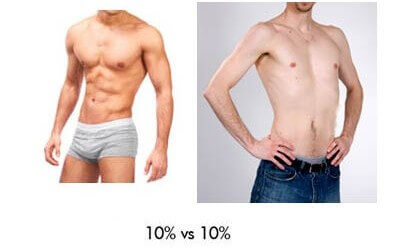
Both are around 10% body fat but the one on the left has quite a bit more muscle, giving him a dramatically different look.
This can make it hard to estimate body fat percentages based on what you see in a picture or mirror, but the following images are a good guideline:
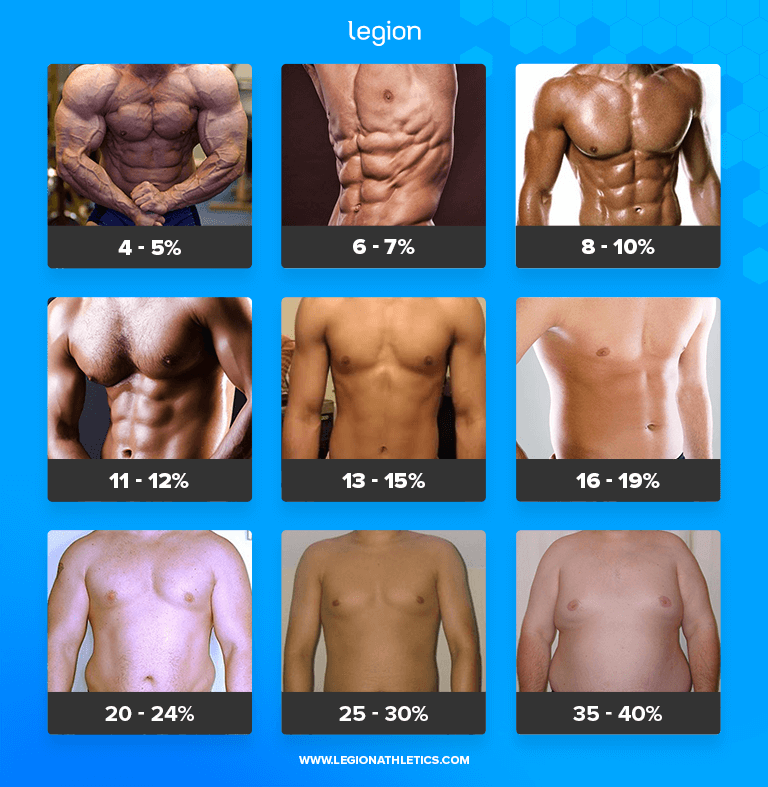
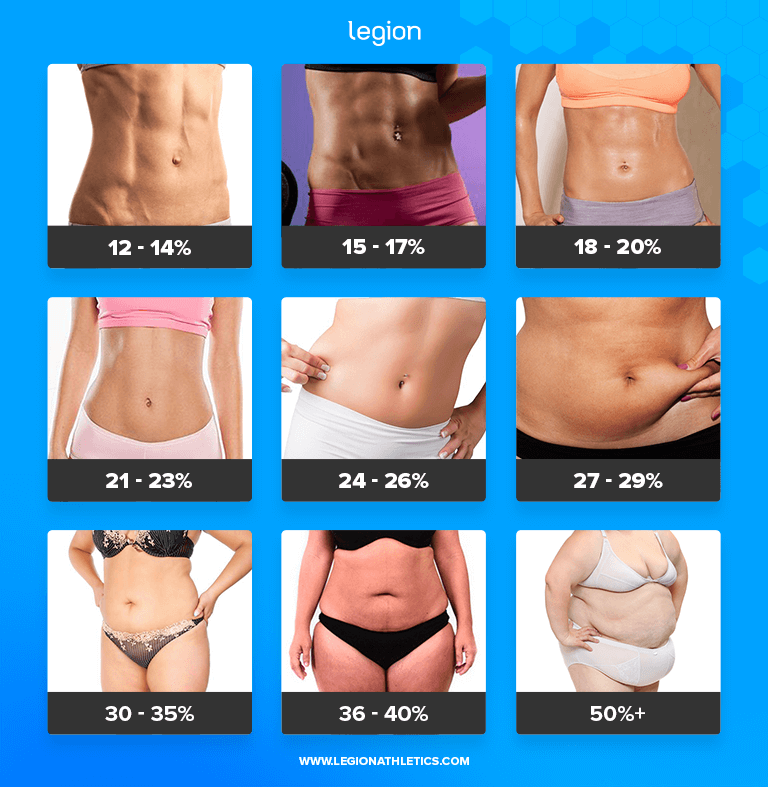
Dual-Energy X-Ray Absorptiometry (DXA)
DXA involves a full-body x-ray to determine total fat and fat-free mass.
This is possible because bone and different body tissues absorb x-ray energy differently.
You’ve probably heard that DXA is a foolproof method of measuring your body fat percentage, but it’s not.
There are several reasons for this:
- Results can vary between machines, even if they’re produced by the same manufacturer.
- Algorithms used to convert raw data into body composition measurements differ and thus outputs can differ.
- The type of x-ray used influences the results.
- Like BIA, hydration status can significantly impact DXA results (even minor changes in the hydration levels of lean mass can be enough to skew results).
- Results are affected by gender, body size, total fat mass, and even disease state.
For example, two studies found that individual error rates using DXA went as high as 4 percentage points.
In another study, individual error rates in the range of 8 to 10 points were seen. In yet another, DXA significantly overestimated decreases in body fat and underestimated increases.
The Bod Pod
The Bod Pod is a machine that measures the amount of air your body displaces inside a sealed chamber and uses equations to translate this into an analysis of body composition.
Like everything else discussed so far, though, the Bod Pod doesn’t measure body composition accurately enough to be relied upon.
For example, in one study, individual error rates were up to 15 percentage points, and in other studies, they’ve ranged from 5 to 6 points.
The crux of the issue with the Bod Pod is its results are affected by all kinds of things like facial hair, moisture, body temperature, and even the tightness of clothing worn inside the chamber.
Magnetic Resonance Imaging (MRI)
An MRI scanner uses magnetic fields and radio waves to produce detailed, 2D images of the inside of your body.
Technicians then carefully analyze the images (a procedure known as postprocessing) to measure how much of your body mass is made up of fat.
The accuracy of MRI is largely dependent on how many of these images are taken. Research shows that trying to estimate body fat based on a sparse set of “slices” gives an imprecise reading of body composition.
Unfortunately, unless you’re willing to part with large sums of money and spend a considerable amount of time in the thin tube of an MRI scanner, the body composition data you get from MRI is not particularly accurate.
This is why MRI is generally only used to measure body composition in scientific studies, where many images can be taken.
How to Measure Body Composition
The easiest way to assess and track changes in your body composition requires just a few things:
- Calipers
- A scale
- A measuring tape
- A mirror
And here’s what to do with them:
Weigh yourself daily and calculate an average every 7 to 10 days.
Your weight fluctuates every day due to things like water retention, glycogen storage, and bowel movements (or the lack thereof).
That’s why flogging yourself over small unwanted increases or decreases in weight is silly and counterproductive. Instead, work with weekly averages, which will show you what’s really happening with your weight.
First thing in the morning each day, after using the bathroom and before eating or drinking, write down your naked weight.
Then, after seven days, add your weights up and divide the sum by seven. That’s your average weight for that week.
Watch those averages over time and you’ll be able to see if things are actually moving in the right direction or not.
Take weekly caliper measurements.
Extrapolating body fat percentage from caliper measurements is hit and miss, but the measurements themselves are quite useful.
If your skin is getting thicker over time, you’re gaining fat. If it’s getting thinner, you’re losing fat.
In terms of what caliper to use, I like the Accu-Measure skinfold caliper because it’s affordable, easy to use, and as accurate as more expensive models.
Since it’s possible to lose or gain fat faster in some places than others, I recommend you take three skinfold measurements in various places on your body:a
- If you’re a woman, take a triceps, thigh, and suprailiac measurement.
- If you’re a man, take a pectoral, abdominal, and thigh measurement.
And here’s how to take the measurements:
- Take all measurements on the right side of your body while standing with your muscles relaxed (flexing will foul your measurements).
- Pinch your skin by placing the thumb and forefinger on your body about two inches apart, firmly pushing them into your flesh and then together, and then gently pulling the skinfold away from your body.
- Measure a pinched skinfold by placing the tips of the caliper in the middle of and perpendicular to it (between your fingertips), compress the caliper until it clicks (and no more), and note the measurement.
- To take a triceps measurement, standing with your right arm at your side (pointing at the floor), have someone pinch a vertical fold of skin on the backside of your arm halfway between the top of your shoulder and your elbow.
- To take a thigh measurement, pinch a vertical fold of skin on the front of your right thigh halfway between your kneecap and the spot where the top of your thigh connects with your hip.
- To take a suprailiac measurement, pinch a diagonal fold of skin directly above the anterior superior iliac spine, which is the bony protrusion on the front edge of your right hip bone.
- To take a pectoral measurement, pinch a diagonal skinfold halfway between your right nipple and the front edge of your right armpit.
- To take an abdominal measurement, pinch a vertical fold of skin one inch to the right of your belly button.
You can use these measurements alone to monitor changes in your body fat or you can plug them into the Legion Body Fat Percentage Calculator to estimate your body fat percentage (just take the result with a grain of salt).
Take weekly waist measurements.
The size of your waist (measured at the belly button) is a reliable indicator of fatness.
If your waist is shrinking over time, you’re losing fat. If it’s growing, you’re gaining fat.
And that’s why I recommend that you note down your waist measurement weekly.
There’s nothing fancy that you need for this—a simple measuring tape will do.
Take weekly pictures.
What you see in the mirror is, ultimately, what matters most.
If you’re gaining muscle and losing fat, you’re going to look better and better, regardless of what the scale or anything else says.
So, take weekly front, back, and side pictures in good, consistent lighting and, over time, your progress (or lack thereof) will be easy to see.
Body Composition Examples
To give you a better sense of how your body changes when you improve your body composition, let’s take a look at some examples, starting with me:
View this post on Instagram
I’m 6’1, 195 pounds, and around 10% body fat.
Here’s Matt . . .

. . . who used my Bigger Leaner Stronger program to go from around 22% body fat to around 10% body fat while building a ton of muscle.
And here’s Chad . . .
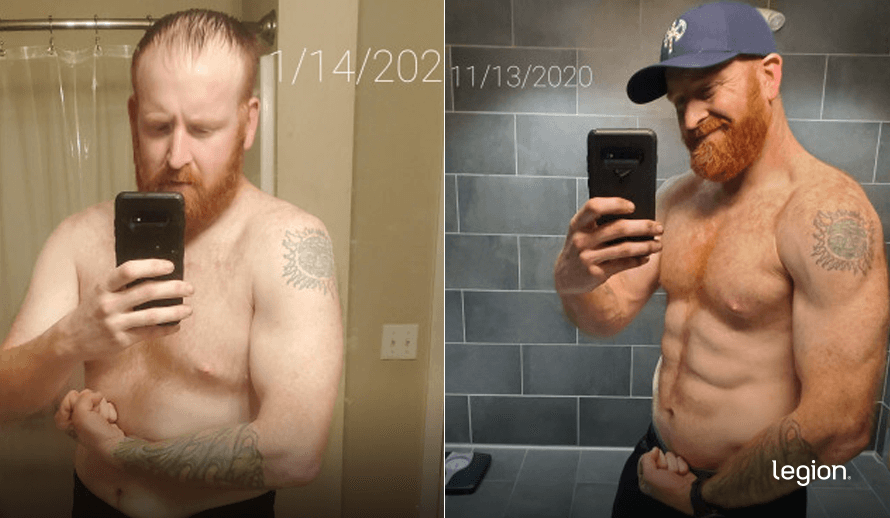
. . . who also used Bigger Leaner Stronger to go from around 25% body fat to around 14% body fat and get jacked in the process.
Then there’s Natasha . . .
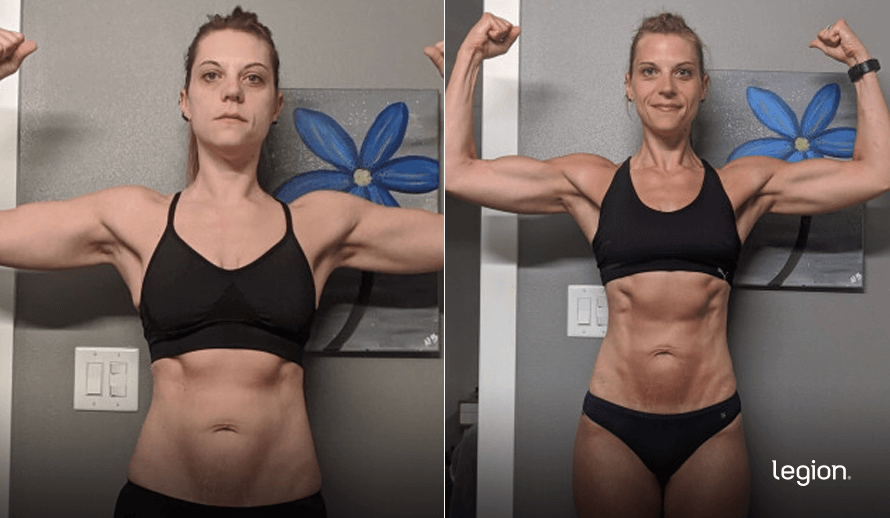
. . . who went from around 25% body fat to around 19% body fat in just 3 months on my Thinner Leaner Stronger program for women.
And finally, here’s Jean . . .
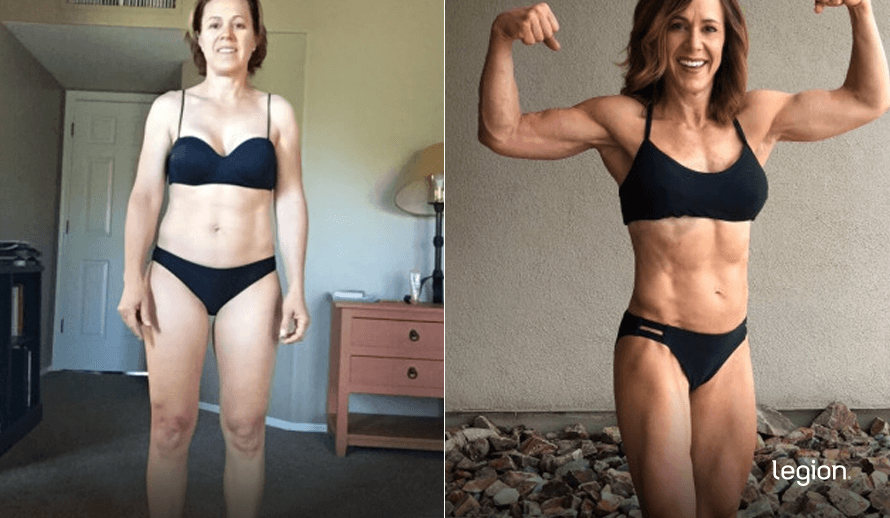
. . . who used Thinner Leaner Stronger to go from 27% body fat to around 18% body fat and get shredded.
FAQ #1: What is a healthy body composition?
Here are the body fat ranges put forward by the American Council on Exercise (ACE) for different types of people:
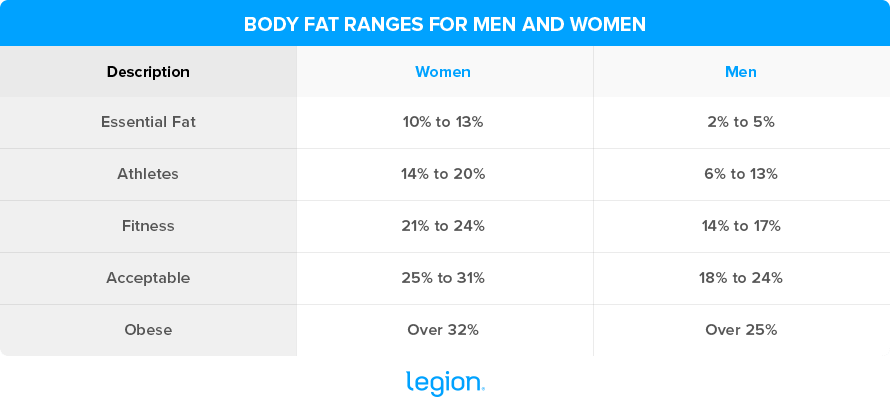
ACE classifies a body fat percentage of under 24% for men and under 31% for women as an “acceptable” level of body fat. The term “acceptable” in this context is pretty difficult to define, but if we take it to mean ”healthy,” I’d say these numbers are too high.
Although you probably won’t encounter immediate health problems at these body fat percentages, you almost certainly will be healthier and feel better if you get leaner.
In my opinion, a healthy level of body fat percentage would be somewhere between 8 to 15% for men and 18 to 25% for women.
In other words, you’ll probably look and feel best if you keep your body fat percentage around the upper end of the “athletic” and low end of the “fitness” range according to the ACE guidelines.
Although whittling down your body fat percentage to even lower than this (less than 8% for men and 18% for women) can be gratifying, it’s not sustainable for the long-term and tends to be more trouble than it’s worth for most people.
FAQ #2: What are the best body composition exercises?
If you want to use exercise to improve your body composition, then you need to be doing a lot of heavy, compound weightlifting.
Contrary to what many “experts” tell you, lifting weights doesn’t just help you build muscle—it helps you lose fat, too. That’s why it’s well suited to improving your body composition.
What do I mean by “a lot of heavy compound” lifting, though?
Well, by “a lot,” I mean three to five times per week.
By “compound,” I mean focusing on compound exercises, which are those that target multiple large muscle groups at once, such as the squat, deadlift, bench press, military press, pull-up.
(Studies show that these are the types of exercises that produce the greatest increases in metabolic rate, muscle mass, and strength.)
And by “heavy,” I mean lifting weights that are above 70% of your one-rep max (weights that you can do 12 reps or less with before failing). Research shows that training with heavy weights not only helps you build more muscle, it helps you burn more fat than training with lighter weights.
Although lifting weights is the best form of exercise to improve your body composition, you also need to follow a proper diet, too.
If you want to learn more about how to improve your body composition, check out this article:
The Complete Guide to Safely and Healthily Losing Weight Fast
FAQ #3: What is the best body composition analysis tool?
The best way to measure your body composition at home is to use a combination of caliper measurements, the scale, and progress pictures.
That said, there’s no way to get a 100% foolproof estimate of your body composition short of dissecting your body and weighing its components (which is . . . impractical).
At this point you may be wondering, how do we know what anyone’s body fat percentage really is? What’s the standard that we compare BIA, DXA, Bod Pod, and so forth against?
The gold standard for measuring body fat percentage is known as 4-compartment analysis, and it involves using several techniques to separate the body into four components:
- Fat mass
- Bone
- Water
- Muscle tissue
This multiplex analysis provides a highly accurate estimate of your body composition, but requires a team of well-trained scientists and several expensive machines.
FAQ #4: What’s the ideal body composition?
There’s no such thing as an ideal body composition.
That said, most men and women will be healthiest, feel best, and look fit if they keep their body fat in the 8-to-15%, or 18-to-25% ranges.
As long as you’re within these “healthy” ranges, the ideal body composition for you depends on your goals and preferences. For example, if you want to excel in sports where leanness is an asset, such as running, cycling, or any sport that has weight divisions (powerlifting, boxing, or MMA), you’ll benefit from being near the bottom of that range.
If you want to have well-defined abs or be particularly vascular, you’ll need to stay under 10% body fat as a man or 20% body fat as a woman.
FAQ #5: How do you improve body composition?
You improve your body composition by building muscle and losing body fat (and not muscle).
This is the case whether you’re a man or a woman.
How much muscle you need to gain and how low your body fat will need to be depends on how you want to look.
Aspiring professional (drug-using) bodybuilders will need to gain 50+ pounds of muscle and reduce their body fat to very low (unhealthy) levels.
The rest of us, though, don’t need to go to such extremes.
I’ve worked with thousands of guys and gals and here’s what I’ve learned:
- The look most guys want requires gaining about 25 to 35 pounds of muscle and being around 8 to 10% body fat.
- The look most girls want requires gaining 10 to 15 pounds of muscle and being around 18 to 20% body fat.
And anyone, regardless of genetics, “body type,” or anything else, can do that.
Scientific References +
- Marx, J. O., Ratamess, N. A., Nindl, B. C., Gotshalk, L. A., Volek, J. S., Dohi, K., Bush, J. A., Gómez, A. L., Mazzetti, S. A., Fleck, S. J., Häkkinen, K., Newton, R. U., & Kraemer, W. J. (2001). Low-volume circuit versus high-volume periodized resistance training in women. Medicine and Science in Sports and Exercise, 33(4), 635–643. https://doi.org/10.1097/00005768-200104000-00019
- Farinatti, P. T. V., & Castinheiras Net, A. G. (2011). The effect of between-set rest intervals on the oxygen uptake during and after resistance exercise sessions performed with large-and small-muscle mass. Journal of Strength and Conditioning Research, 25(11), 3181–3190. https://doi.org/10.1519/JSC.0b013e318212e415
- Fatouros, I. G., Chatzinikolaou, A., Tournis, S., Nikolaidis, M. G., Jamurtas, A. Z., Douroudos, I. I., Papassotiriou, I., Thomakos, P. M., Taxildaris, K., Mastorakos, G., & Mitrakou, A. (2009). Intensity of resistance exercise determines adipokine and resting energy expenditure responses in overweight elderly individuals. Diabetes Care, 32(12), 2161–2167. https://doi.org/10.2337/dc08-1994
- Shen, W., Chen, J., Gantz, M., Velasquez, G., Punyanitya, M., & Heymsfield, S. B. (2012). A single mri slice does not accurately predict visceral and subcutaneous adipose tissue changes during weight loss. Obesity, 20(12), 2458–2463. https://doi.org/10.1038/oby.2012.168
- Thomas, E. L., & Bell, J. D. (2003). Influence of undersampling on magnetic resonance imaging measurements of intra-abdominal adipose tissue. International Journal of Obesity, 27(2), 211–218. https://doi.org/10.1038/sj.ijo.802229
- Fields, D. A., Hunter, G. R., & Coran, M. I. (2000). Validation of the BOD POD with hydrostatic weighing: Influence of body clothing. International Journal of Obesity, 24(2), 200–205. https://doi.org/10.1038/sj.ijo.0801113
- Fields, D. A., Higgins, P. B., & Hunter, G. R. (2004). Assessment of body composition by air-displacement plethysmography: Influence of body temperature and moisture. Dynamic Medicine, 3(1), 1–7. https://doi.org/10.1186/1476-5918-3-3
- Higgins, P. B., Fields, D. A., Hunter, G. R., & Gower, B. A. (2001). Effect of scalp and facial hair on air displacement plethysmography estimates of percentage of body fat. Obesity Research, 9(5), 326–330. https://doi.org/10.1038/oby.2001.41
- Collins, M. A., Millard-Stafford, M. L., Evans, E. M., Snow, T. K., Cureton, K. J., & Rosskopf, L. B. (2004). Effect of race and musculoskeletal development on the accuracy of air plethysmography. Medicine and Science in Sports and Exercise, 36(6), 1070–1077. https://doi.org/10.1249/01.MSS.0000128182.76254.05
- Fields, D. A., Wilson, G. D., Gladden, L. B., Hunter, G. R., Pascoe, D. D., & Goran, M. I. (2001). Comparison of the BOD POD with the four-compartment model in adult females. Medicine and Science in Sports and Exercise, 33(9), 1605–1610. https://doi.org/10.1097/00005768-200109000-00026
- Evans, E. M., Saunders, M. J., Spano, M. A., Arngrimsson, S. A., Lewis, R. D., & Cureton, K. J. (1999). Body-composition changes with diet and exercise in obese women: A comparison of estimates from clinical methods and a 4-component model. American Journal of Clinical Nutrition, 70(1), 5–12. https://doi.org/10.1093/ajcn/70.1.5
- Clasey, J. L., Kanaley, J. A., Wideman, L., Heymsfield, S. B., Teates, C. D., Gutgesell, M. E., Thorner, M. O., Hartman, M. L., & Weltman, A. (1999). Validity of methods of body composition assessment in young and older men and women. Journal of Applied Physiology, 86(5), 1728–1738. https://doi.org/10.1152/jappl.1999.86.5.1728
- Van Marken Lichtenbelt, W. D., Hartgens, F., Vollaard, N. B. J., Ebbing, S., & Kuipers, H. (2004). Body Composition Changes in Bodybuilders: A Method Comparison. Medicine and Science in Sports and Exercise, 36(3), 490–497. https://doi.org/10.1249/01.MSS.0000117159.70295.73
- Van Der Ploeg, G. E., Withers, R. T., & Laforgia, J. (2003). Percent body fat via DEXA: Comparison with a four-compartment model. Journal of Applied Physiology, 94(2), 499–506. https://doi.org/10.1152/japplphysiol.00436.2002
- Williams, J. E., Wells, J. C. K., Wilson, C. M., Haroun, D., Lucas, A., & Fewtrell, M. S. (2006). Evaluation of Lunar Prodigy dual-energy X-ray absorptiometry for assessing body composition in healthy persons and patients by comparison with the criterion 4-component model. American Journal of Clinical Nutrition, 83(5), 1047–1054. https://doi.org/10.1093/ajcn/83.5.1047
- Prior, B. M., Cureton, K. J., Modlesky, C. M., Evans, E. M., Sloniger, M. A., Saunders, M., & Lewis, R. D. (1997). In vivo validation of whole body composition estimates from dual-energy X-ray absorptiometry. Journal of Applied Physiology, 83(2), 623–630. https://doi.org/10.1152/jappl.1997.83.2.623
- Ioannidou, E., Padilla, J., Wang, J., Heymsfield, S. B., Thornton, J. C., Horlick, M., Gallagher, D., & Pierson, R. N. (2003). Pencil-beam versus fan-beam dual-energy X-ray absorptiometry comparisons across four systems: Appendicular lean soft tissue. Acta Diabetologica, 40(SUPPL. 1). https://doi.org/10.1007/s00592-003-0034-x
- Peterson, M. J., Czerwinski, S. A., & Siervogel, R. M. (2003). Development and validation of skinfold-thickness prediction equations with a 4-compartment model. American Journal of Clinical Nutrition, 77(5), 1186–1191. https://doi.org/10.1093/ajcn/77.5.1186
- Jackson, A. S., & Pollock, M. L. (1978). Generalized equations for predicting body density of men. British Journal of Nutrition, 40(3), 497–504. https://doi.org/10.1079/bjn19780152
- Khaled, M. A., McCutcheon, M. J., Reddy, S., Pearman, P. L., Hunter, G. R., & Weinsier, R. L. (1988). Electrical impedance in assessing human body composition: The BIA method. American Journal of Clinical Nutrition, 47(5), 789–792. https://doi.org/10.1093/ajcn/47.5.789
- Slinde, F., & Rossander-Hulthén, L. (2001). Bioelectrical impedance: Effect of 3 identical meals on diurnal impedance variation and calculation of body composition. American Journal of Clinical Nutrition, 74(4), 474–478. https://doi.org/10.1093/ajcn/74.4.474
- Lukaski, H. C., Bolonchuk, W. W., Hall, C. B., & Siders, W. A. (1986). Validation of tetrapolar bioelectrical impedance method to assess human body composition. Journal of Applied Physiology, 60(4), 1327–1332. https://doi.org/10.1152/jappl.1986.60.4.1327
- Bergsma–Kadijk, J. A., Baumeister, B., & Deurenberg, P. (1996). Measurement of body fat in young and elderly women: comparison between a four-compartment model and widely used reference methods. British Journal of Nutrition, 75(5), 649–657. https://doi.org/10.1079/bjn19960170
- Bosy-Westphal, A., Later, W., Hitze, B., Sato, T., Kossel, E., Glüer, C. C., Heller, M., & Müller, M. J. (2008). Accuracy of bioelectrical impedance consumer devices for measurement of body composition in comparison to whole body magnetic resonance imaging and dual X-ray absorptiometry. Obesity Facts, 1(6), 319–324. https://doi.org/10.1159/000176061










